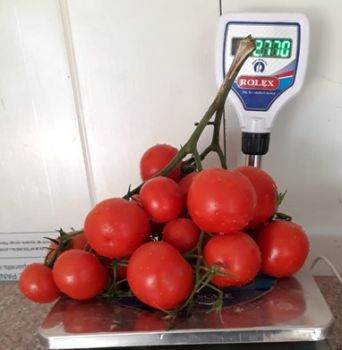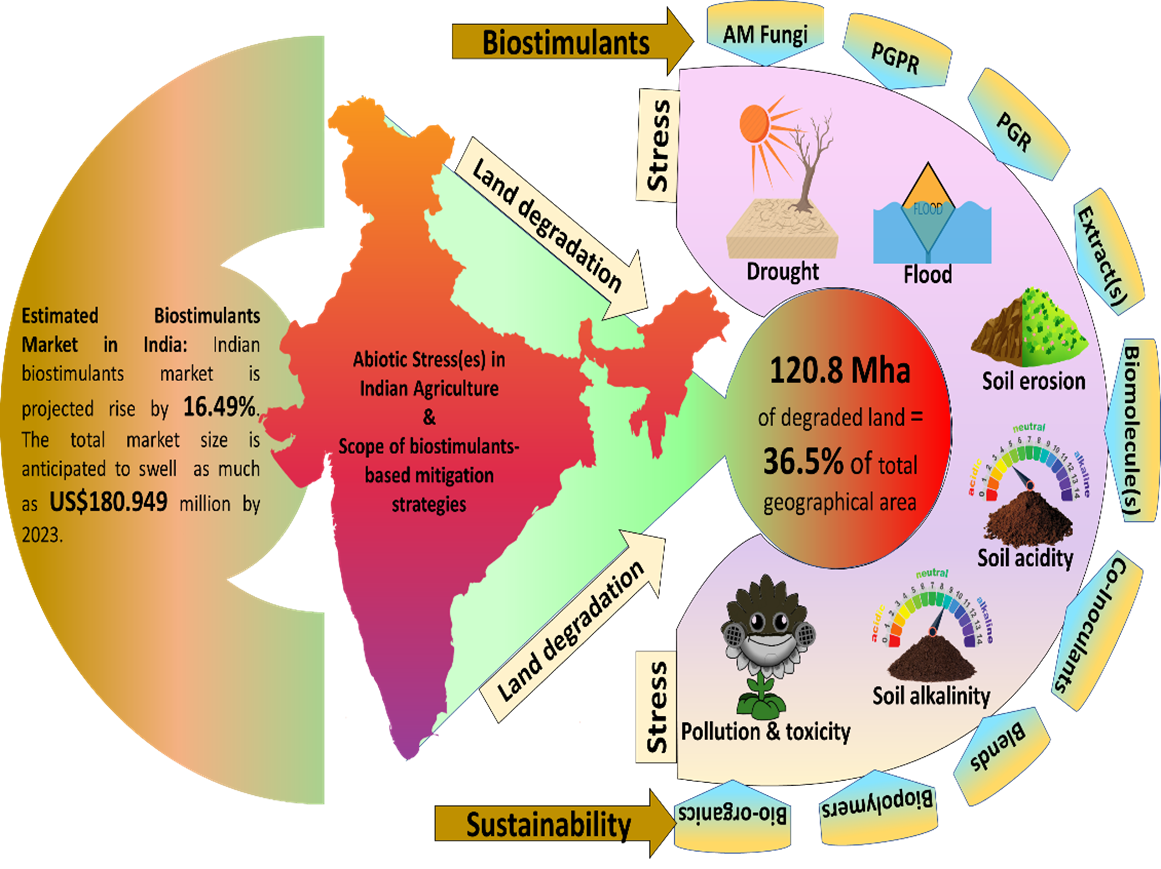BIOSTIMULANTS IN AGRICULTURE: AN INDIAN PERSPECTIVE
By: K. K. Meena and Pradeep Kumar*
Division of Integrated Farming System, ICAR-Central Arid Zone Research Institute, Jodhpur, INDIA
*Correspondence: pradeep.kumar4@icar.gov.in

Climate change is the major challenge in achieving the doubled agricultural yield, and hence, the global goal of zero hunger by 2030. The current non-sustainable chemical-based agriculture practices is reflecting declining trend in agricultural productivity in many parts of the world which may be a potential factor for food crisis. The situation is further going to more aggravate in coming days due to climate change. The Indian subcontinent being a tropical country may face more severe challenges than expecting. India is home for around 17.7 % of the global population with merely 2.4% land and 4% fresh water of total world’s available land and water, respectively. According to the recent World Bank Development Indicators, the agricultural land share in India is 60.4%. However, as much as two-third of the cultivated area in India is completely dependent on monsoon for water requirements. Further, increasing urbanization, pollution, chemical contamination, and uncontrolled use of synthetic agro-inputs have worsen the already threatening situation posed by constantly increasing frequency of abiotic stress incidences – particularly acute and chronic drought, high temperature, flash floods, erratic precipitation, deteriorating soil health, and land degradation due to diverse anthropogenic causes.
Cumulatively, these circumstances may pose challenge to sustainable agricultural crop production, thereby threatening the food security in coming years. In this context, sustainable interventions are critically needed to retain the desired rate of crop production irrespective of the adverse environmental pressure(s) instigated by climate change.

Considering the multi-advantageous nature of biostimulants in terms of several plant benefits and environmental friendliness, their applicability as stress-mitigators in agriculture has been seriously attended since past few years that yielded promisingly successful response in crops grown in open fields or protective environments that dramatically increased the scope of existing agricultural-biostimulant industry by several folds. The global biostimulants market has been projected to achieve an economy of USD 4.47 billion by 2025. Similarly, since 2015, Indian biostimulants market has dramatically crossed the mark of USD 315 million, of which the chain of distributors and retailers constitute the largest segment (60-65%) followed by different schemes run by societies, agricultural boards, and state and central Government (around 20-30%), speciality segments such as greenhouse cultivators, organic, and IPM farmers, and exporters (around 10-15%), and seed industry (2-3%). With the increasing demand for sustainable alternatives and organic food, the Indian biostimulants market is anticipated to witness a CARG of 16.49%, indicating a huge scope for biostimulant industry. Looking to the surge in the biostimulants market in India so as to maintain the quality of biostimulants, Govt. of India clearly defines regulations for the registration of biostimulants in recent announced order “Fertilizer (Inorganic, Organic or Mixed) (Control) Amendment Order 2021”, on February 23, 2021. As per this order, the biostimulants are defined as “substance or microorganism or a combination of both whose primary function when applied to plants, seeds or rhizosphere is to stimulate physiological processes in plants and to enhance its nutrient uptake, growth, yield, nutrition efficiency crop quality and tolerance to stress, regardless of its nutrient content, but does not include pesticides or plant growth regulators which are regulated under the Insecticide Act, 1968 (46 of 1968)” (BASAI, 2021).
Several initiatives have been taken at national as well as regional levels to meet out the increasing demand for biostimulants; for instance, the Government of India granted a budget of around INR 1,260 million to nurture the Startup India Seed Fund during the FY 2021-22. However, despite the rigorous efforts at the national as well as grassroot level, there exists a general lack of awareness among the farmers regarding the use of biostimulants. Further, given the limited availability of production setup, ensuring a timely distribution of the product(s) in desired quantities might be difficult with increasing demand in coming future. Dissemination and awareness initiatives on biostimulants is another concern in India as currently around 138 million Indian farmers own an average land size of 1.15ha, while the existing extension mechanisms are under pressure due to the availability of one extension personnel for every 800-1000 farmers. Thus, there remains huge dearth of efforts for generating awareness and promoting the use of biostimulants for sustainable farming in India. Given their ease-of-utility, storability, stability, and potent action under relatively harsh environments, next gen biostimulants such as biopolymers, microbe-based non-living products, biomolecule-based formulations, and botanical extracts need specific promotion attempts. Biostimulants such as biopolymers are also known for their ability to enhance soil carbon pool which is a need-of-the-hour for achieving a dual purpose of sinking atmospheric CO2 in the form of soil organic carbon, so as to manage the increasing CO2 levels within the atmosphere, while simultaneously promoting soil carbon-build up for better soil health in long term. Thus, biostimulants application in combination with other sustainable agronomic approaches like use of resistant cultivars, resistant rootstock-based grafted seedlings, protective environment, water conservative irrigation practices and suitably recycled farm-waste derived amendments will not only ensure relatively sustainable yields in highly stress-prone areas (e.g., arid and semi-arid regions), but also potentially improve the ecosystem services of the existing agricultural systems, and secure environmental sustainability for future generations.
Tilman, D., Balzer, C., Hill, J., and Befort, B. L. (2011). Global food demand and the sustainable intensification of agriculture. Proc. Natl. Acad. Sci. U.S.A. 108, 20260–20264. doi: 10.1073/pnas.1116437108.
García-García AL, García-Machado FJ, Borges AA, Morales-Sierra S, Boto A and Jiménez-Arias D (2020) Pure Organic Active Compounds Against Abiotic Stress: A Biostimulant Overview. Front. Plant Sci. 11:575829. BASAI, 2021. BASAI Presentation: Webinar on Biostimulants Regulations under FCO 1985 (Aug. 4, 2021): https://www.psfc.org.in/docs/basai.pdf(fetched on 10.09.2021).



